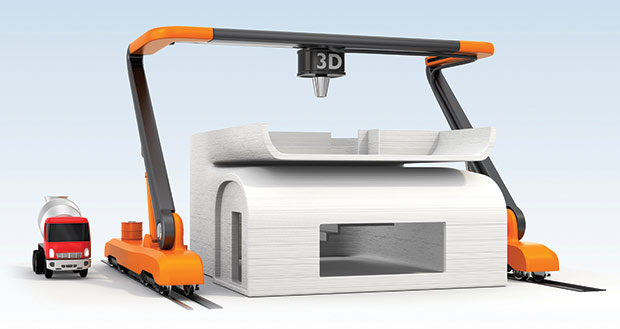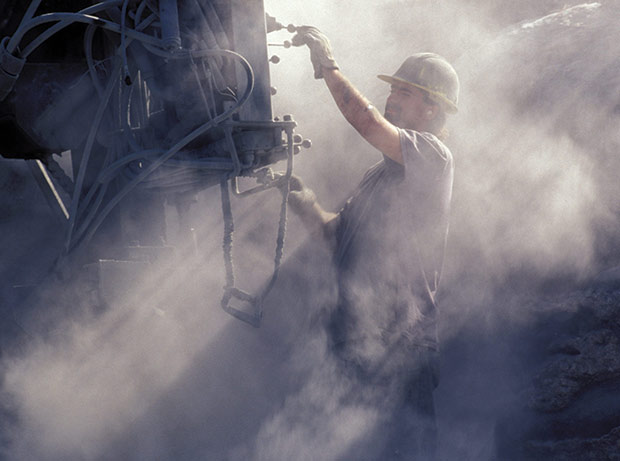3D Construction Printing – You can print anything, but should you?
By: WISCONSIN LAW JOURNAL STAFF//March 29, 2016//
3D Construction Printing – You can print anything, but should you?
By: WISCONSIN LAW JOURNAL STAFF//March 29, 2016//

By Kimberly Hurtado
Hurtado Zimmerman SC
Three-dimensional printing is the hottest, new technology for building information modeling data in the construction industry.
Stereolithography and other dimensional-printing methods have been around since the late 1980s as an alternative to machine tooling, extrusion and casting processes, but only recently have they become sufficiently swift and affordable to be used in construction. Experimentation in the last few years has given rise to an astonishing range of construction applications.
It is now possible to print entire scale models of buildings complete with color 3D topography surrounding them. Architectural details such as existing relief moldings and curved trims can be laser scanned and then printed to create exact matched pieces.
New building materials, such as ceramic bricks and cementitious ceiling tiles, can be made in virtually any shape with predetermined openings precisely located to permit mechanical and electrical work to pass through them without the need for coring. Some of the new metal and reinforced concrete printed components are sufficiently strong that they have structural bearing capacity. There is even experimentation with printing entire buildings in segments that are assembled together in stacks like Legos.
For certain applications, 3D printing has the potential to be faster and more inexpensive than other methods of fabrication, so 3D printing is finding its way into construction projects all over the U.S., Europe and Asia.
The basic idea behind 3D printing is that a three-dimensional shape is made by programing a 3D printer to extrude material in specific shapes, much like a baker squeezes frosting from a tube. The extruded substrate material is then fixed layer upon layer to form a 3D piece. There is a growing range of substrate materials currently being used, including powdered and liquid plastics, glass, metals, mud and recycled concrete, and the method of joining layers can be chemical, thermal, ultraviolet light or simply evaporative.
Until the past few years, the size of objects a 3D printer could create was small — having less volume than a 2-foot cube — but as the construction industry pushes the boundaries of meaningful uses for 3D printed objects, the demand for larger printers has risen.
Currently, the largest 3D printers are able to print architectural components measuring more than 10 meters high and wide, and the size of these printers continues to grow.
The possible applications of 3D printed technology are literally out of this world. For example, one of the most sophisticated processes available in the U.S. is being explored by NASA for the construction of housing on Mars. There is also experimentation with hydrophilic 3D printed materials that deflect in the presence of water but then return to their original shape when dried. Another impressive use is the 3D printing of disaster-relief shelters, using indigenous, locally available materials such as sand, dirt and water and a portable printer.
Quite literally, a 3D printer can print any shape that can be imagined. With the technical limitations of this technology, however, it is prudent to think through which applications make sense for construction. Clearly, scale-model production and architectural-detail matching are among the most promising uses. Imagine the cost of having to restore a broken Louis Sullivan ceramic façade detail by recreating a mold and casting ceramic or carving replacement pieces by hand. Then imagine how much less it would cost if you used a laser scan of the damaged area to determine the exact shape of the needed restoration piece, a second scan of undamaged areas to duplicate material patterns, and then printed a 3D replacement that fits into the damaged area perfectly.
By comparison, the use of large 3D-printed building components is truly only in an experimental phase. With them, prudent designers and constructors will be exploring not only new 3D production technologies but will also need to prepare for potential additional costs. For example, building inspectors will need to be convinced new composite printed materials are structurally, thermally and otherwise sound and capable, when these materials haven’t been around long enough to even know how long they can be expected to last.
Consider, too, that who is assigned to make and install these materials may generate labor disputes — should an operating engineer be the one placing precast concrete wall segments or should it be a mason? Which party should be responsible to hire the designer who programs a 3D printer to fabricate 3D components offsite? Is it the same party if fabrication will occur onsite?
Another significant concern will be insurance coverage. Designers and contractors using this technology will need to secure custom riders to their commercial general liability and professional liability coverages because there are no specific coverages available for 3D-printed technology. They may also need product liability coverage depending on how the 3D printing is generated and if it is created on or offsite.
Lastly, because 3D printers and the substrate materials they use may be proprietary, it will be important to make sure that those who turn to 3D technology have the appropriate licensing. These licenses will need to be broad enough to permit reuse and potential adaptation by the owner of a completed 3D printed assembly or structure.
Imagine a Star Trek-like replicator/printer sitting in your kitchen and printing out plastic forks and spoons for your picnic, then creating a 3D-printed version of your child’s art project, after which you print a new handle to repair your briefcase. All of these projects can be created right now, using current 3D technology at a cost that is becoming more affordable every day.
For the present, however, those wanting to explore 3D printing for construction should learn about the limits of various joining methods and the substrates that are used to build printed components, make it a point to ignore the sales hype surrounding what companies that sell printers maintain is possible with 3D printing, and consider carefully whether conventional methods of production might still prove more affordable or still produce a more desirable result.
Kimberly Hurtado, CM-BIM, is the managing shareholder of Wauwatosa-based Hurtado Zimmerman.
Legal News
- Wisconsin attorney loses law license, ordered to pay $16K fine
- Former Wisconsin police officer charged with 5 bestiality felony counts
- Judge reject’s Trump’s bid for a new trial in $83.3 million E. Jean Carroll defamation case
- Dozens of deaths reveal risks of injecting sedatives into people restrained by police
- The Latest: Supreme Court arguments conclude in Trump immunity case
- Net neutrality restored as FCC votes to regulate internet providers
- Wisconsin Attorney General asks Congress to expand reproductive health services
- Attorney General Kaul releases update at three-year anniversary of clergy and faith leader abuse initiative
- State Bar leaders remain deeply divided over special purpose trust
- Former Wisconsin college chancellor fired over porn career is fighting to keep his faculty post
- Pecker says he pledged to be Trump campaign’s ‘eyes and ears’ during 2016 race
- A conservative quest to limit diversity programs gains momentum in states
WLJ People
- Power 30 Personal Injury Attorneys – Russell Nicolet
- Power 30 Personal Injury Attorneys – Benjamin Nicolet
- Power 30 Personal Injury Attorneys – Dustin T. Woehl
- Power 30 Personal Injury Attorneys – Katherine Metzger
- Power 30 Personal Injury Attorneys – Joseph Ryan
- Power 30 Personal Injury Attorneys – James M. Ryan
- Power 30 Personal Injury Attorneys – Dana Wachs
- Power 30 Personal Injury Attorneys – Mark L. Thomsen
- Power 30 Personal Injury Attorneys – Matthew Lein
- Power 30 Personal Injury Attorneys – Jeffrey A. Pitman
- Power 30 Personal Injury Attorneys – William Pemberton
- Power 30 Personal Injury Attorneys – Howard S. Sicula







